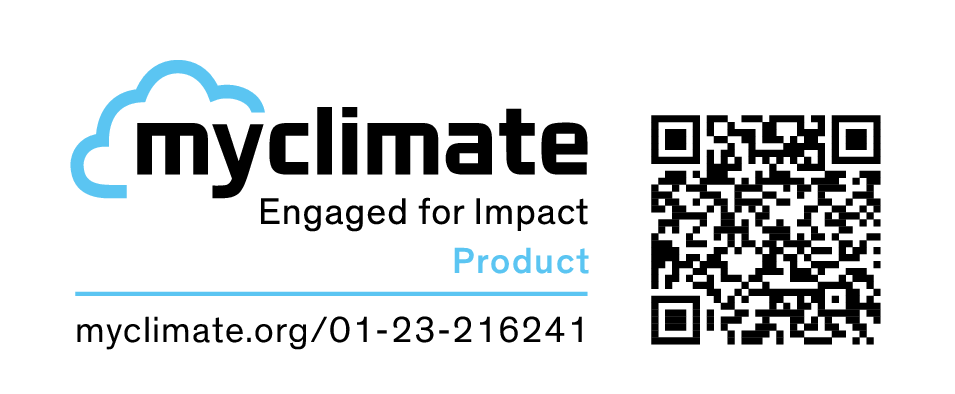How we contribute to climate protection
We already focused on calculating our company’s carbon footprint in 2020 with myclimate – this included travel between our locations in Zurich and Belgrade, the commute to the office, the office buildings themselves, and the entire IT system. Since 2021, we’ve been taking a more targeted approach: We’re not just calculating our carbon footprint as a company, but also the «Product Carbon Footprint (PCF)» for all neon accounts. Based on the calculated greenhouse gas emissions, we make a contribution to climate protection by supporting climate protection projects through myclimate.
What exactly does the «Product Carbon Footprint (PCF)» mean?
To put it simply: myclimate has calculated how many greenhouse gas emissions a neon green account emits per year – including all aspects from the extraction of raw materials to the programming of the app and the life cycle of a card. Our CO2 footprint as a company is also included in this calculation. Based on these calculations, we support one of myclimate's carbon offset projects – in our case a biogas project for small farmers in Vietnam, more on this below.

Scan the QR code or click here to access our certificate.
Why do you offset with myclimate?
The international initiative with Swiss roots is currently effective in more than 140 carbon offset projects in 41 countries. myclimate's local anchoring and yet international scope convinced us, as did its quality awareness, the diversity of projects and its many years of experience through cooperation with major players, especially in the Swiss market. myclimate uses at least 80 percent of the offsetting funds for the projects on site - the rest covers the administration and internal foundation costs. In addition, all myclimate projects contribute to at least one of the Sustainable Development Goals (SDGs).
So how much greenhouse gas is emitted by a neon (green) account?
If app use is included, a neon account emits 3.46 kg CO2e per year, which corresponds to 692 tonnes CO2e per year for around 200'000 users. Excluding app use, it would be 3.35 kg CO2e per year and account, which corresponds to 670 tonnes CO2e per year.
Note: the small «e» after CO2 stands for so-called CO2 equivalents (CO2e). Besides carbon dioxide (CO2), there are 6 other relevant greenhouse gases* that contribute to climate change. Due to their different physical properties, these gases also have a different effect on the climate, which is why the emissions produced are converted into CO2 equivalents (CO2e). These quantify how much a certain amount of a greenhouse gas contributes to global warming compared to the same amount of CO2. For example, the CO2 equivalent for nitrous oxide over a period of 100 years is 265, i.e. one ton of nitrous oxide has the same influence on the greenhouse effect as 265 tons of CO2.
* Methane (CH4), nitrous oxide (N2O), hydrofluorocarbons, perfluorocarbons, sulphur hexafluoride (SF6) and nitrogen trifluoride (NF3).
What are the detailed greenhouse gas emissions?

The purchase of our services causes the most greenhouse gas emissions (69.2 %), our locations in Zurich and Belgrade account for a quarter of the emissions, and app use is in third place. The more than 9 million transactions carried out by neon users and the cards - from production to transport to the user to disposal - are less relevant for the total greenhouse gas emissions.
The biggest aspect of app use is the manufacture of the mobile phone. In the spirit of «feel free», we don't tell you which phone to use - neon works on Android devices, iPhones and Huawei. But you can still help improve our footprint (and yours!) by using your phone longer. With the additional three-year guarantee on newly purchased electronic products that is included with your neon green account, this is already possible without any disadvantages. Read more about the warranty extension here.
How can we improve our footprint?
Since most of our carbon footprint comes from service providers, our options are limited – but there is room for improvement. For example, we can choose to work with service providers who are also committed to the environment.
Our partner bank Hypothekarbank Lenzburg reduces CO2 emissions wherever possible. For the remaining, inevitable amount of CO2 emissions, they support sustainable climate projects via myclimate in the same amount. In addition, we can further reduce our footprint by cycling and using public transport for our commutes to work – or by eliminating them altogether by working from home.
What must not be forgotten is that everything we consume and pay for with the neon account causes greenhouse gas emissions that are not included in the balance. After all, the 100 CHF spent at the gas station generate more of a footprint than 100 CHF spent at the eco-shop.
Our climate project: Turning waste into biogas for small farmers in Vietnam
Residents of rural areas in Vietnam often face the challenge of securing energy, especially for daily cooking. Traditional fuels such as firewood or charcoal are expensive, harmful to the environment, lead to respiratory problems due to the open cooking areas and the collection of the material is time-consuming.
Biogas replaces the smoky cooking stoves and is a more sustainable solution: Accumulating animal dung, kitchen waste and waste from connected toilets are collected in an underground reservoir. The decomposition of the mixture in the reservoir produces methane gas, which can be used for the connected gas cookers in the kitchens. The residues (so-called «bioslurry») are reused by the farmers as organic fertiliser on their fields. The biogas plants thus not only avoid the emissions caused by firewood, but also prevent free-lying pig manure from freely emitting the climate-damaging methane.
Further information and benefits of the biogas project in Vietnam can be found here.
